Hair loss on a dog’s tail can occur due to a variety of conditions. Some are temporary while others may require life-long management. To provide a starting point for dog parents, integrative veterinarian Dr. Julie Buzby explains the causes, symptoms, and treatment for 10 conditions that cause dogs to lose hair on their tails.
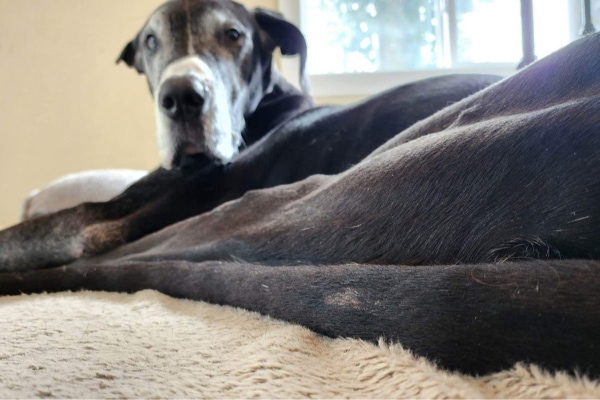
Hair loss on a dog’s tail, body, legs, or head is one of the more common reasons for veterinary visits. Since there are a variety of reasons dogs may develop bald spots, it is up to the veterinarian to do some detective work to find the underlying cause.
This very scenario played out in my office. My patient, Regal, a senior Beagle, was itchy and had a large bald patch on his tail. While performing the physical exam and asking his mom questions about her pup, my mind was running through the common reasons dogs may be losing hair on their tails.
We will get to those reasons soon. But first I want to help you recognize abnormal hair loss on your dog and point out some other common “clues” that can help solve your dog’s hair loss mystery.
How much hair loss is a problem?
As you know from looking at your floors, couch, and clothes, some dogs shed a lot and others seem to barely shed at all. The exact amount of shedding depends on your dog’s breed and haircoat. But for most dogs, some daily hair loss is normal. In fact, it’s more than just normal—it’s actually a good thing. Shedding helps keep your dog’s coat clean and shiny by removing old or damaged hairs.
However, if your dog’s hair seems to be falling out more than normal, this could be a sign there is something wrong. Usually dogs shed fairly uniformly, so noticing sections of the fur that are thin or patchy is also cause for concern. And if your dog’s hair loss has progressed to complete baldness (i.e. alopecia) in areas, this is definitely abnormal.
While hair loss can happen anywhere on your dog, the most common locations are the head (around ears and eyes), stomach, back, and tail. In this article, we are going to focus specifically on hair loss on a dog’s tail.
What symptoms might I see in addition to hair loss on a dog’s tail?
While every condition that causes alopecia has its own set of signs, there are some common symptoms that may accompany the hair loss:
- Excessive scratching, itching, biting, or licking at the area
- Red or irritated skin
- Musky or foul odor
- Dry, scaly, or cracked skin
- Swelling of the affected areas
- Discharge or blood coming from the skin
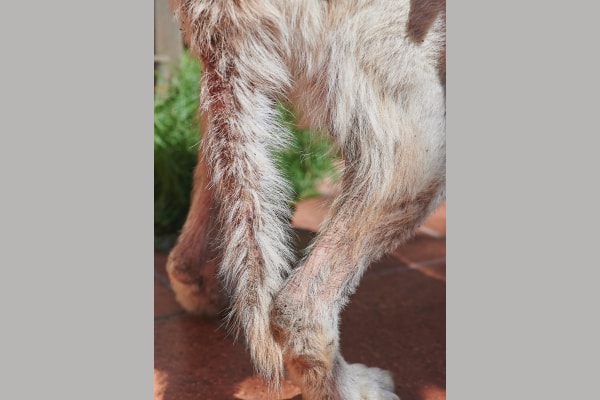
However, there are also a few causes of hair loss on a dog’s tail that leave the skin looking pristine. Instead, the dog may exhibit symptoms like:
- Behavior changes
- Increased or decreased thirst or hunger
- Changes in urination frequency or amount
If you see any of these symptoms accompanying alopecia in your dog, please consult your veterinarian. Your dog could have one of these 10 causes of hair loss on a dog’s tail.
#1: Fleas
When I hear a dog is losing hair near or on his or her tail, some of the first conditions I consider are fleas and flea allergy dermatitis (FAD). These annoying, free-loading parasites can be very distressing for your dog. Flea bites are painful. Plus, some dogs are allergic to flea saliva, which means even a few flea bites can cause intense itching.
If your dog has fleas, you will probably see him or her scratching excessively. Sometimes, you can even see the small, red flea bites. Plus, you may notice hair loss, skin irritation, and crusts and scabs, especially over the neck, the back near the tail, the tail itself, and back legs. These locations tend to be hit the hardest because they are the areas fleas like to frequent.
Finding fleas
If you see these signs, I recommend checking your dog for fleas. Some people like to part the hair with their fingers to look for fleas or flea dirt (i.e. “flea poop,” which looks like reddish coffee grounds). Others prefer to use a flea comb. This is a very fine-toothed comb that, as you run it through your dog’s fur, will pick up fleas or flea dirt.
Managing fleas
If you suspect that you found fleas or flea dirt with the comb (or your fingers), contact your veterinarian. I know it can be tempting to hop on Amazon or run out to the store to pick up an over-the-counter flea product. But this often isn’t a safe or effective approach.
Your veterinarian can recommend prescription flea control products that are right for your dog and situation. Plus, he or she can advise you about how to control flea life stages in the environment. And your vet can also treat any secondary bacterial skin infections (i.e. pyoderma in dogs) that may have happened as a result of your dog chewing or scratching at his or her skin.
For all these reasons, the vet, not the pet store, is the place to go if your dog has fleas.
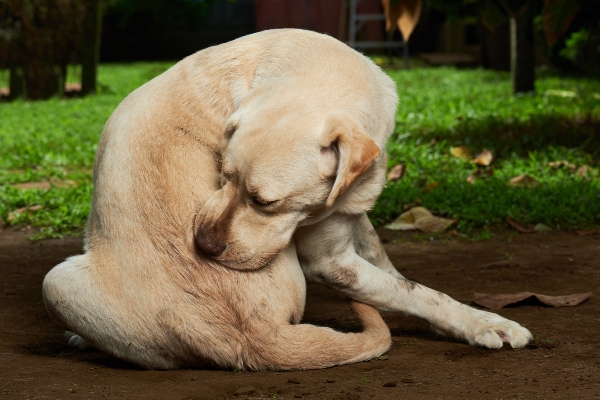
#2: Demodectic mange
Fleas are not the only parasite that can cause our furry friends to lose hair. Demodex mites (the cause of demodectic mange) are another external parasite that could be the culprit.
Typically, demodectic mange is seen in young dogs (under the age of one year) with an immature immune system. However, senior dogs, dogs with a disease that causes a weakened immune system, or dogs on immunosuppressive medications, are also more prone to demodectic mange.
As gross as it sounds, demodex mites live in the skin of every dog in small numbers. Normally, the immune system keeps the population in check. But in dogs with a weak or immature immune system, sometimes demodex mites can reproduce out of control.
Large numbers of demodex mites can start causing skin issues like patchy hair loss, which typically starts on the face and around the eyes, but can spread all the way to the tail. Affected dogs may also have dry, irritated, or crusty skin. Usually dogs with demodectic mange aren’t itchy initially, but if they develop a secondary infection, they may start to scratch or rub their skin.
Treatment for demodectic mange
While this sounds bad, the good news is that this disease is not contagious to other dogs or humans. And as the puppy’s immune system matures, it will usually begin to take care of the problem on its own.
However, if you suspect your dog has demodectic mange, it is still best to make an appointment with your vet. This is especially important in adult and senior dogs because they tend to have more severe cases which do not resolve on their own.
After assessing your dog and confirming the diagnosis, the vet can make some treatment recommendations. They may include an anti-parasitic drug to kill the mites, and topic shampoos and medications to speed up the healing process.
#3: Environmental and food allergies
If your dog is free of parasites but still losing hair and itching, the next cause to rule out is allergies. I already mentioned that dogs can be allergic to flea saliva. But they can also suffer from food allergies or environmental allergies.
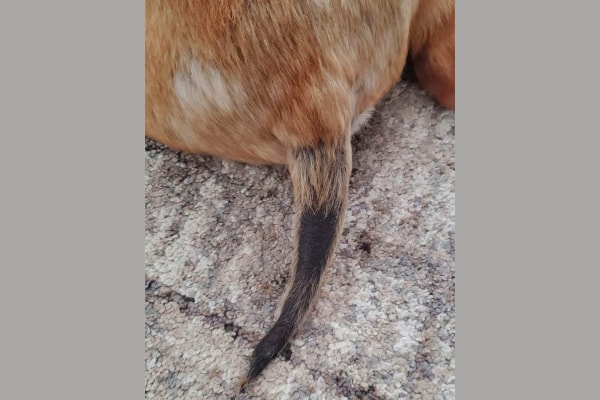
Photo Courtesy of D. Hargreaves
If dogs lose hair near their tail and on their extremities (i.e. feet and legs), belly, and/or face, I am often suspicious of an allergic reaction. Many of these dogs also have secondary ear infections (i.e. otitis in dogs) or bacterial or yeast skin infections (e.g. dog paw yeast infections).
To help determine if allergic dermatitis (i.e. allergic skin disease) could be the culprit, and if it is more likely to be food or environmental (or both), your vet may ask these questions:
- Do the itching and hair loss happen year-round or only at certain times of the year? If year-round, is it consistent or does it increase during some seasons?
- Do the symptoms seem to be worse or the same after your dog has been outside?
- Do any activities (e.g. rolling in the grass) seem to make the symptoms worse?
- Have there been any recent changes in your dog’s environment?
Depending on the answers, and the results of the physical examination and diagnostic testing (e.g. skin or ear cytology or culture), your vet can help you create a plan. This may involve a food trial (i.e. feeding your dog a novel food) and/or allergy medicine for dogs.
Unlike parasites, allergies tend to be a life-long issue and they don’t have a quick and easy fix. However, the sooner you can work with your vet to detect and control your dog’s allergies, the better. This is one of the many reasons having a strong partnership with your vet is so important.
#4: Anxiety
When we see dogs chewing on themselves, we often think they are itchy or uncomfortable (like with fleas or allergies as discussed above). However, sometimes consistent licking of a body part is a coping mechanism for behavioral disorders like anxiety instead.
Dogs with anxiety can get restless and fidgety, and they might need something to focus on to distract them from being anxious. Conveniently, they have tails and feet within easy access all the time.
This makes the tail (and feet) a perfect stress-reducing chew toy. Sometimes you might catch your dog in the act of chewing or sucking on his or her tail or pulling hair out. But other times, especially if your dog is mainly anxious when you are not there, it may be not so obvious that your dog is causing the hair loss on his or her tail.
Clues that your dog is secretly (or not so secretly) chewing on his or her tail include:
- Portions of the tail being wet from saliva
- Brittle, broken, or damaged areas of hair on the tail
- Rust-colored salivary staining on your dog’s fur
Anxiety indicators
Plus, you may see more generalized signs of anxiety like:
- Increased or unexplained panting
- Whining, whimpering, and barking
- Destroying walls, carpet, furniture, etc. when you are gone
- Hiding or withdrawing from social interactions (with you or other pets)
- Fear of loud noises (e.g. storms or fireworks)
- Excessive pacing (especially if someone leaves the room or the environment is busy)
- Gulping down food
Dogs often act quite differently at the vet clinic than they do at home. Thus, if you think your dog may suffer from anxiety, it can be helpful to record your observations and bring them to the vet appointment. This can help you have a successful vet visit and give your vet the information he or she needs.

Together, you can create a plan to reduce your dog’s anxiety. This may involve changes in your dog’s routine or environment, anxiety-reducing medications like trazodone for dogs, or other anxiety-management techniques. Hopefully, with the right combination of interventions, your dog will feel calmer. And he or she will stop chewing and ripping hair out of his or her tail.
#5: Stud tail (tail gland hyperplasia)
Another reason a dog may be losing hair on his or her tail is tail gland hyperplasia. This condition is also known as “stud tail” because it is most common in intact male dogs. However, neutered male dogs and intact and spayed female dogs can also get stud tail.
The characteristic feature of tail gland hyperplasia is a focal bald spot on the top of the tail. Usually it occurs close to the base of the tail (about 2.5-5 cm from the anus). The bald spot corresponds with a collection of oil and scent glands in the skin.
Sometimes these glands can become enlarged, impacted, or infected. This causes oily secretions to accumulate in that region. As a result, the hair can become matted, fall out, or be pulled out by your dog while he or she is cleaning the area. The plugged glands can also cause that region of the tail to become painful and swollen. And the skin may darken or even turn black. If the dog develops a secondary bacterial infection in that area, the skin may also become itchy, crusty, or irritated.
If you suspect your dog has stud tail, it is best to consult your veterinarian. He or she is often able to diagnose tail gland hyperplasia based on the appearance of the tail. But sometimes your vet may suggest additional diagnostics to rule out other causes of hair loss or identify an underlying cause of the stud tail (e.g. hormone imbalance). Treatment usually involves addressing the underlying cause (if found) and using topical or systemic anti-microbial and anti-inflammatory medications.
#6: Cushing’s disease
Two endocrine diseases, hyperadrenocorticism (i.e. Cushing’s disease) and hypothyroidism, can also lead to alopecia on a dog’s tail (and other body parts). We will address Cushing’s disease now and hypothyroidism next.
Cushing’s disease in dogs occurs when the adrenal glands produce too much of a steroid known as cortisol. Cortisol is a hormone that the body needs to help regulate glucose levels, metabolism, and the immune system. However, excessive amounts of cortisol (i.e. hyperadrenocorticism) are a bad thing.
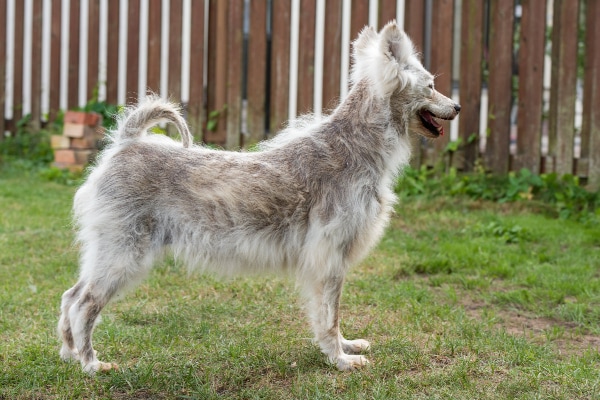
Senior dogs are most prone to Cushing’s disease. They tend to have symptoms such as:
- Increased thirst in dogs
- Increased urination
- Increased appetite
- Pot-bellied dog appearance
- Decreased energy (i.e. being a lethargic dog)
- Heat intolerance
- Poor haircoat and hair loss
Dogs with Cushing’s disease usually begin losing hair around their abdomen. Then the hair loss will progress down the back, toward the back legs, and to the tail. However, typically Cushing’s does not cause dogs to lose hair on the head or near the ears.
If you suspect your dog is experiencing hair loss due to Cushing’s or showing other symptoms on the list, it is important to seek veterinary care. Your vet can usually diagnose your dog with hyperadrenocorticism based on one or more blood tests. But sometimes he or she might also recommend additional diagnostics. Then after reaching a diagnosis, your vet will talk to you about medications like trilostane for dogs that can help normalize cortisol levels and manage your dog’s symptoms.
#7: Hypothyroidism
The other endocrine problem that can cause hair loss on your dog’s tail is hypothyroidism in dogs (i.e. low thyroid hormone levels.). Thyroid hormones help regulate a dog’s metabolism, so it is important that they are present in the appropriate amounts.
If the thyroid starts to produce fewer thyroid hormones, it can lead to symptoms such as:
- Weight gain (especially without an increase in food consumption)
- Pot-bellied appearance
- Decreased energy
- Cold intolerance
- Flaky skin
- Hair thinning and worsening coat conditions
- Skin infections
Interestingly, the hair loss in hypothyroidism often starts on either side of the trunk or on the tail. In fact, a “rat tail” (i.e. a tail that has little or no hair) is a classical sign of hypothyroidism. Over time, the hair loss may move to the rest of the body.
A trip to the veterinarian is warranted if you have started to suspect your dog has hypothyroidism. Sometimes hypothyroidism can be a little tricky to diagnose since some non-thyroid conditions can also cause low thyroid hormone levels on blood work. But if your dog does end up truly being hypothyroid, there is a medication your dog can take to replace the missing thyroid hormones. Often, once thyroid levels are corrected, the dog’s hair will grow back.
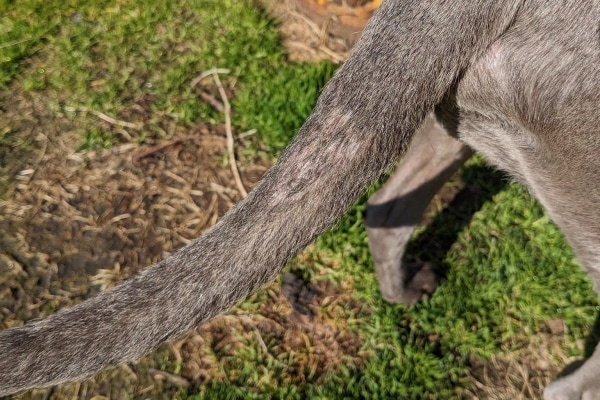
Photo courtesy of: K. Chan
#8: Anal gland problems
While hormone imbalances like the ones discussed above can cause your dog’s tail hair to fall out, a painful anal gland impaction or abscess might cause your dog to start pulling out the hair.
Anal glands are small, oval-shaped sacs that are located on both sides of a dog’s anus. They produce a fluid that has a strong, fishy smell to it. (So if you are wondering “Why does my dog smell like fish?, the answer may lie in the anal glands.)
Normally, dogs empty these glands when having a bowel movement. However, the fluid inside can sometimes become thick—almost like toothpaste. As a result, the anal gland could become difficult for your dog to express on his or her own. This can be uncomfortable and lead to your dog scooting his or her rear end on the carpet.
Dogs who are not emptying their anal glands need them physically expressed by a veterinarian. Otherwise, if the gland is full for too long, it can sometimes become painful and infected. When this happens, your dog may start chewing on his or her rear or tail and pulling hair out. Also, you may notice that your dog keeps licking the base of the tail in an effort to relieve the pain.
Treatment for anal gland trouble
If you notice your dog scooting, straining to defecate, or biting at the hind end, I recommend taking him or her to a veterinarian promptly. It is better (and more comfortable for your dog) if your vet can express the anal glands before they become severely inflamed or infected.
For a simple anal gland impaction, gland expression may be the only treatment your dog needs. But for more significant anal gland issues (e.g. anal gland abscesses), the vet may need to flush out the anal gland and/or start your dog on anti-inflammatories and antibiotics.
#9: Tapeworms
A less stinky, but perhaps more gross, reason your dog might be chewing at his or her hind end and losing tail hair is tapeworms. These parasites live in your dog’s intestines. Periodically, tapeworm segments, which look like grains of rice, will break off the worm and exit the anus.
These segments can stay attached to the hair around your dog’s anus and cause irritation. As a result, the dog may start excessively scratching, biting, or licking at the rear end and tail region. This can lead to bald patches on or under the tail.
Plus, since dogs can acquire tapeworms from ingesting a flea that is carrying the tapeworm larvae, dogs who have tapeworms may also have fleas. This makes them extra itchy.
If you see tapeworm segments on your dog’s rear end or on his or her bedding, please schedule an appointment with your veterinarian. That way he or she can examine your dog, potentially perform fecal tests for dogs to look for any other intestinal parasites, and then prescribe the appropriate deworming medication. Additionally, your vet will want to review your dog’s flea control program since fleas transmit tapeworms.
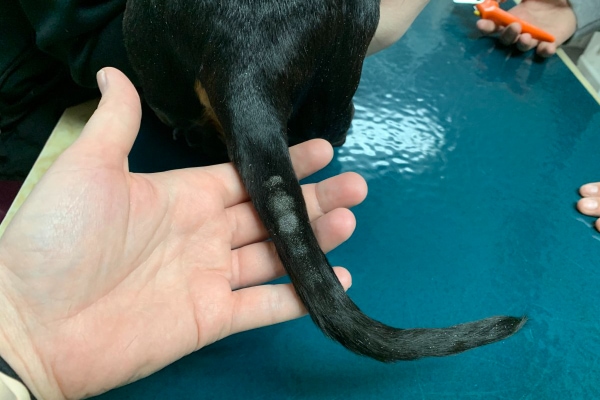
#10: Poor nutrition
Hair growth and coat quality are associated with your dog’s overall health. That’s why systemic diseases like Cushing’s disease can impact a dog’s skin and coat so quickly. But nutrition is also very important for your furry friend’s hair.
Hair growth requires multiple nutrients, vitamins, minerals, and proteins. Without these important nutrients, a dog’s coat could become dull, dry, and brittle, or the dog may develop dandruff. And if a dog continues to not receive proper nutrition, the hair may begin to fall out, often starting with the tail hair.
The tail is particularly vulnerable to nutrition-related hair loss because the hair follicles on the tail are different than those elsewhere on the body. Most of your dog’s hair follicles produce multiple, long, thick hairs. However, the hair follicles on the tail usually only produce a single hair at a time. Therefore, if poor nutrition (or another health condition) is impacting hair growth, your dog’s tail is likely to be one of the first places to thin and develop hair loss.
Thankfully, though, with good nutrition and help from your veterinarian, your dog’s coat and tail hair should start regrowing and gaining back their luster.
Back to Regal
Remember Regal the Beagle from the beginning of this article? Well, after walking through my top ten causes for hair loss on a dog’s tail and completing the physical exam, his mom and I agreed that the symptoms seemed to match up with anxiety. Regal had a long history of separation anxiety. And his mom had occasionally caught him pulling hair out of his tail and paws in the past.
However, to ensure that there wasn’t another underlying cause for the hair loss, I ran some bloodwork and checked a skin cytology. Everything came back perfectly normal, so I recommended starting my anxious patient on an anti-anxiety medication and making a few adjustments to the routine at home.
I’m happy to say that when he trotted into my office a month later for a recheck, he had a full, shiny coat of hair that went all the way to the tip of his tail!
Work with your vet to find the cause of hair loss on your dog’s tail
Hopefully, this can be your dog’s story too. If you notice hair loss on your dog’s tail, please make an appointment with your veterinarian. He or she can help you figure out which of these 10 causes was the culprit (or if it was a different condition). And your vet can work with you to create a plan that gets your dog’s haircoat and tail in tip-top shape again soon.
Why was your dog losing hair on his or her tail?
Please comment below.


My 12+ year old husky had such a beautiful bushy tail and now it looks pathetic and scraggly.. It looks matted but I think because there is so little hair it looks that way. He does not chew at it and it doesn’t seem to bother him but it bothers me. His thyroid bloodwork is normal. About 3 years ago he was getting bald patches where his fur would come out in clumps. His vet diagnosed him with a fungal infection. I took him to a dermatologist and they diagnosed him with a zinc deficiency which they said was common in Huskies and some other big dogs. They prescribed zinc tablets and Vit D. I haven’t had to give him the zinc for awhile as he was no longer losing fur. I noticed a spot the other day on his belly where he is losing fur again. Do you think the tail “mange” look is related to any of this?
Hi Sue,
I am sorry your Husky is experiencing these issues with hair loss on his tail. It is possible this is the same zinc related problem as before, but it would be hard to tell without ruling out other causes first. You could always start giving the zinc and vitamin D again to see if things improve. Ultimately, it sounds like a visit to your vet may be needed. Hoping for clear answers and an easy solution. Wishing you both the best of luck!
My husky is approaching 13 years old in February, 2025. Last yeat about January, I noticed a lump on her flank. It grew pretty large. Vet said it was a sarcoma. I treated it wit fenbenzadole in about a week it started hairing over, and in two months it was gone or at least completely haired over, wound healed (dog had ripped part of it out). With Fenben, I changed her diet and did not feed her dog food for six months, going for organic beef, salmon etc. Also did closer watch on water to make sure it was clean. She also had allergies prior to sarcoma with opposite front foot to sarcoma exhibiting lameness. She was given allergy and joint tabs with meals. Her tail was just fine, but now she has substantial hair loss for about the last four months. She is not a good patient. Can’t do anything with her without giving her a sedative, so options for closely examing tail and washing it is out unless taken to a vet put her under for treatment. Not sure what to do.
Hi Christopher,
I am sorry you are facing this difficult situation with your Husky. I wish I could offer advice, but it is hard to make specific recommendations without being able to personally examine your pup. Unfortunately, the only way to get a diagnosis and find the appropriate treatment may be to schedule an appointment with your vet. I understand how stressful this can be when dealing with a dog that experiences anxiety with vet visits. There are a few options for medications that you can administer at home that will help with fear aggression and anxiety prior to arriving at the clinic. I encourage you to discuss this with your vet and see what they recommend. Hoping for quick answers and a clear path forward. Best wishes and good luck!
I brought my senior miniature pinscher inside after hanging letting him enjoy the sun all day and he’s suddenly lost most of the hair on his tail? He hasn’t been inching it and doesn’t have any sores that I can see and his behavior is his normal happy self. it has me baffled. we haven’t changed his environment at all.
Hi Olivia,
I understand your concern for your pup with this strange hair loss. Unfortunately, without being able to examine your boy myself, it is hard to make specific conclusions. While there are many things that can cause hair loss, I cannot think of any that would cause it to be “sudden”. Your best course of action is to have him evaluated by your vet so they can try and get a definitive diagnosis. Hoping for clear answers and praying for a positive outcome for your sweet boy.
Same situation with my miniature pinscher/chihuahua mix. Once i see the hair loss on his tail I use a medicated shampoo for yeast and parasite control and I liberally spray the tail with banixx. Seems to work pretty well and the hair grows back within a couple days. However, it’s continually happening like a cycle per say.
Hi Ruben,
I am sorry you are having these recurring issues with hair loss on your pup. Since it is cyclical, it makes me very suspicious about fleas. The way the flea life cycle works is once adult fleas are present, they start laying eggs within 24 hours. Most flea products can only kill the adults and not the eggs or larva. So, once the eggs have been laid, it can take 2-3 months for them to complete their life cycle and emerge as adults. If a flea problem is suspected, then you would need to be very consistent with treatment for at least 3 consecutive months to completely control the population. I am glad you have found what works for you pup when these flare ups occur. Hoping you can find a solution and ensure this doesn’t have to be a lifelong problem for your girl. Wishing you both all the best.
My dog is a 4 1/2yr old mastiff pit mix 110lb fixed male. He started out with red rings and hair loss at the same time on his tail entire tail stopped at his rump. We moved from hot and dry So Cal to wet and cold NY. He has been smelling like Doritos and started getting round raised flaky grey skin patches and losing hair only on his the ridge of his back no where else. I have also noticed he has had a couple of stools that seemed like they had a slimy film coating. I have tried different anti-fungal shampoos coconut oil, but nothing is working. Today I tried washing him and then rubbing apple cider vinegar. I also just switched his dog from purina to Iams. I don’t have the cash to keep feeding the vet and my dog and my kids. Do you have any suggestions? I almost thought it may be ringworm as well. But I don’t see the redness until after I wash off the crusty red bumps after his baths. I don’t know what to do. Next I may buy him some oxygen shampoo or sulfur shampoo. I don’t have ringworm and this has been going on for 6months now. I don’t want him to lose all his hair. I don’t know if it’s a diet issue or yeast infection or ringworm.
Hi Vanessa,
I am sorry your big guy is having these worrisome skin issues. Without knowing the cause, it is hard to give advice on how to treat this. Has your vet done a skin scrape to see what kind of organisms are growing on the skin? I would assume your boy is probably dealing with allergies or atopy of some kind. I you truly want to get to the bottom of this issue I would recommend a referral to a veterinary dermatologist. There is some cost upfront, but it may end up saving you money in the long run if you don’t have to continue with trial and error with home remedies. Hoping you can get the answers you need to restore your sweet boy’s health. Best wishes to you and yours.
We’re struggling with Happy Tail Syndrome in an almost 2 year old lab. Dog was fine and then bloody tail mess everywhere. Somehow keeps breaking the very tip open. I’ve been wrapping with a syringe to protect it since January. I’m starting to get weary 😩 The tail around injury sites has lost hair. Any suggestions?
Hi KJ,
I am so sorry you are dealing with this frustrating situation in your young Lab. In cases where bandaging is not enough to allow for the tail to heal, I have had to move forward with tail amputation. It sounds terrible but can be the best way to prevent ongoing injury and pain. Does your vet have the ability to do laser therapy? It may be worth a try to see if it can speed up healing time. Hoping you can find a way to get your boy back on the right track. Praying for clarity and peace for all involved. ♥
Our Great Pyrenees is almost 12 and has a “rat tail”. it started at the tip of her tail over a year ago and the fur loss has accelerated over the past 8 months to being very sparse over 1/2 of her tail. She doesn’t have any of the other symptoms listed. Her thyroid was tested by Dr. Jean Dodds less than a year ago and was found to be in normal range for her breed and age. She eats a high quality balanced raw diet. She does have a plum sized lipoma next to the base of her tail that our vet is monitoring. Could that be related to her tail fur loss? Do you have any suggestions on what potential causes we should investigate? She is in good health otherwise and. takes no medications just some joint and immune supplements.
Hi Lesley,
I understand your concern for your big girl. I would not expect the lipoma to be causing hair loss on the tail unless it is starting to bother your pup and is causing her to chew at the area. I am glad to hear that the thyroid testing was normal. Has she been tested for Cushing’s? If not, that would be my next recommendation. If needed, you can always ask for a consultation with a veterinary dermatologist. Also, you could talk to your vet about supplementing with melatonin to see if there are any beneficial effects. Here is a link to another article with more information: Can I Give My Dog Melatonin? Hope for Hair Loss and More
Hoping you can find some answers for your sweet girl. Wishing you both the best of luck and keep up the good work!
Hi,
I have a 4 year old female pitbull who has in the last few weeks started licking her paws and legs incessantly. her front more than the back but she has what appears to be either a yeast infection or an allergic reaction according to our vet via video (we live very rural so visits are not so easy to do). We have been treating with probiotic sprays and supplements as well as changed her food one containing both a prebiotic and prebiotic formula. She seemed to have less redness then suddenly last night it was worse and I noticed her hair on her tail is thinning. Rarely she is ever left alone so she has never been seen biting at her tail or feet or anything only licking. She’s had no environmental changes at all. my vet has no idea via video what could be causing this. I should also note that for years she has had very little to no hair behind her ears but the vet never found a cause even after in person visits and tests. I just want my baby to feel better as soon as possible. We do have an appointment with our vet but not until next month because of my limited ability to travel (seizure disorder in myself). Any thoughts and suggestions would be greatly appreciated!!
Hi Ashley,
I am so sorry your girl is struggling with this irritating skin problem. Without knowing the cause, it is hard to make specific recommendations. There are some home remedies that may be worth a try. Here are links to other articles with more information:
1. Dog Paw Yeast Infections: Symptoms, Treatment, and Prevention
2. Your Dog’s Itchy Paws: 5 Causes and 6 At-home Remedies
3. Allergy Medicine for Dogs: 9 Solutions to Calm Your Dog’s Itch
Hoping you can find a way to offer your pup some relief while you wait for her appointment. Best wishes and good luck!
“Thank you for providing me with all the helpful information. It has really assisted me in trying to determine what could be wrong with my ten-week-old puppy. I have noticed that she has a thinning spot on her tail, and I have taken a picture of it which I have sent to my vet. I am hopeful that they can figure out what’s going on and provide a suitable remedy.”
Hi Cassie,
I am glad the article was helpful. It was a great idea to send a picture to your vet. Hoping you can get your pup in for an exam soon and get a definitive diagnosis. I am certain your vet will have some great advice and together you can ensure your little pup is well taken care of. Best wishes!
I have a four month old miniature schnauzer and he has a bald spot on his tail which I thought was a ringworm, but it is a bacterial infection. I’ve been treating it for two months now and it seems to be getting bigger and no hair growing back has anyone experienced this?
Hi Melissa,
I am sorry your young puppy is having issues with hair loss on his tail. If his condition is worsening despite treatment, then I would suspect there is something else contributing to this problem. It would be a good idea to talk to your vet and see if there are other tests they can offer to narrow down the cause. Wishing you the best of luck!
Good afternoon, I read the comments and replies on tail hair loss. I am determined to find out my dogs problem. So far, 3 different vets could not help me, although each had opinions ranging from allergies to an estrogen deficiency. I don’t see her biting or chewing on her tail at all. However, she does scratch at her ears and under her chin quite often. There r no bald spots in those areas.
She has been losing tail hair for 10 months now and is heading to the rat tail dilemma. She has nice skin w no visible dandruff, fleas or sores. Her tummy is a nice soft pink.
The latest recommended treatment is for yeast in her ear (for the scratching, although if she does have this problem it is at the early stages. I think my vet just wanted to give me something as I was so frustrated. He did say he was stumped as to her tail hair loss.
Hi Rita,
I am sorry you are in this situation with your dog and have been left with more questions than answers. I know you mentioned you have taken your dog to three different veterinarians. Have you thought about a referral to a dermatologist? When dealing with a case that is complicated and not straight forward, I like to lean on the expertise of a specialist. From what you describe I too am suspicious there is probably an allergy component to your pup’s problem. Hoping you can get some answers soon and find the best way to offer your girl some relief.
My Mastiff suffered from “ratstail” for years.
My Vet tried all sorts of remedies and explored all the possibilities but nothing worked.
One day I decided to study the topic myself and eventually found an article that attributed hair loss on dogs tail as..
A Dietary Difficiency in ” Taurine”
Taurine is found in all raw meat products and is essential to dog diet and health.
Most meat based dog foods are highly processed and subsequently striped of nutrition and most importantly Taurine.
With nothing to lose I “googled” Taurine and found that you can purchase Taurine in tablet form or as dry powder. I bought the tablets and eager awaited their arrival.
When they final arrived I began a daily dose with my dog daily meals as prescribed.
Within 3 weeks..my dog looked like Bazil brush. So much hair had grown and completely replace the unsightly bare skin rat tail. He looked like a different dig.
The bad news is…A Taurine deficiency can lead to other complications and in my dogs case it was the development of Heart disease. “conjestive heart failure”
If I had more aware a couple of years earlier I could have prevented the disease that did eventually cost him his life at age 9.
Not sure why my Vet or the “experts” didn’t know about this.
Dear Stephen,
I am sorry for the tragic loss of your Mastiff and thank you for being willing to share your experience with us. This is all very interesting, and I completely understand why your vet would not have suspected a taurine deficiency. Taurine deficiency is usually diagnosed in cats because they lack the ability to synthesize this amino acid in their own bodies. Dogs on the other hand have this capability. So even when they are not consuming taurine, they can break down other amino acids and produce taurine on their own. It has only recently been discovered that certain dog breeds may be genetically disposed to develop a taurine deficiency. Of the breeds listed, the Mastiff is not included. Also, the symptoms that are seen with taurine deficiency are attributed to heart disease (as you mentioned), brain dysfunction, eye problems, and urinary issues. Skin problems and hair loss are not common (though possible) so I can see how with this being your dog’s only symptom it could be easy to miss. I am sorry you were not able to find answers before complications had already taken place. Again, thank you for sharing this valuable information. Your boy’s legacy will live on and may be the key to saving another pup’s life.
My senior dog has none of the symptoms above and still has a bald tail hair has fallen out over the years she is 13 runs around like a puppy eats well and well behaved
She is receiving anti itch injections every month without it her belly gets very red and raw after many checks ect vets still can’t find out what the problem is has been going on for years
First started after I had her spayed at 3 yrs old and got worse over the years
Hi Karen,
I am sorry your girl has been dealing with these issues for so many years. I hope the injections will continue to offer relief and allow her to stay comfortable and itch free. Thank you for being willing to share your experience with us. Wishing you and your sweet girl the best.
Several of your posts this month have been very poignant for me. I just lost my sweet pibble last summer and in the years before she suddenly and unexpectedly died, she had several of the conditions you’ve been talking about: urine scald and stud tail being the two most recent. Unfortunately, 3 separate veterinary clinics were unable to ever do anything to help her (two of them had never heard of stud tail even though I came in asking about it, and one dismissed it out of hand even though it was the same upside down triangle shape of nearly every picture on the internet – this is why I went to 3 separate clinics). It was very frustrating. Not only did I spend literally thousands of dollars trying to ease her discomfort, more importantly, she never got any relief.
I’m very grateful for your posts. It’s obvious you are knowledgeable and that you care, and it helps all of us advocate better for our pups. I only adopt large/giant breed seniors (my pittie girl becoming an exception when my husband found her abandoned and close to death in the Sierra Nevada foothills), which is a double hit to the wallet but they’re always worth every penny. Being a proactive guardian, my best defense is the offense of being informed. So, thank you!
Hi Jessicah,
I am sorry your girl had to go through so much in her last years of life. Thank you for caring for her and being willing to take in so many big senior pups that need love. I appreciate the kind words and positive feedback about the articles. Wishing you the best. Keep up the good work!